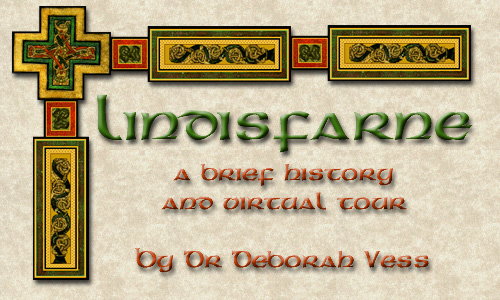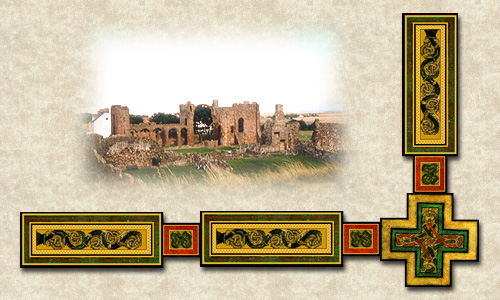
|
||
|
The Hermitage of Sts. Aidan and Cuthbert
The West Facade of the Priory at dusk
Index
IntroductionLindisfarne is known as the "Holy Island." When the Vikings ransacked Lindisfarne in 793, Alcuin, writing from the court of Charlemagne, described Lindisfarne as a "place more venerable than all in Britain." The first mention of Holy Island is in 570, when it was known as Inis Metcaut (island of strong winds) and indeed the winds are strong on this tiny little island.
Brief History of LindisfarneLindisfarne was founded when King Oswald of Northumbria asked monks from Iona to found a monastery there. Corman was the first monk to come; he found the Anglo-Saxons to be barbarians, and resistant to conversion. One of his brethren, Aidan, told him that "it seems, brother, that you have been too hard on your ignorant hearers. You should have followed the practice of the Apostles, and begun by giving them the milk of simpler teaching until title by little, as they were nourished on the Word of God, they grew capable of greater understanding." He got the job. Aidan selected Lindisfarne in part because it reminded him of his home on Iona, but also because the tides cut the island off twice daily. In his Ecclesiastical History, Bede wrote that, "as the tide ebbs and flows, the place is surrounded twice daily by the waves of the sea like an island, and twice, when the sands are dry, it becomes again attached to the mainland."
The tides provided the necessary isolation for a contemplative community, but also did not cut the island off so completely that the Celtic monks could not evangelize the Northumbrian countryside. The island was also very near Oswald's stronghold of Bamburgh, which offered further protection.
Aidan came to Lindisfarne in 635 and became the first Bishop of Northumbria (then known as Bernicia). Aidan was a worker, and not one for spectacular visionary experiences. Bede wrote that, "his life is in marked contrast to the apathy of our times. He gave his clergy an inspiring example of self-discipline and continence, and the highest recommendation of his teaching to all was that he and his followers lived as they taught. He never sought or cared for worldly possessions, and loved to give away whatever he received from kings or wealthy folk. Whether in town or country, he always traveled on foot, unless compelled by necessity to ride, and whenever he met anyone, high or low, he stepped and spoke to them. If they were heathen, he urged them to be baptized; and if they were Christians, he strengthened their faith and inspired them by word and deed to live a good life and be generous to others. Aidan cultivated peace and love, purity and humility; he was above anger and greed and despised pride and conceit. He set himself to keep and teach the laws of God, and was diligent in study and in prayer. He used his priestly authority to check the proud and the powerful; he tenderly comforted the sick he relieved and protected the poor. I greatly admire and love all these things about Aidan, because I have no doubt that they are pleasing to God." Aidan was bishop for sixteen years, during which time four brothers helped him evangelize the Northumbrians: Cedd (Essex), Chad (Mercia), Caelin , and Cynebil. Aidan influenced Hild, a young woman who had been baptized along with King Edwin and other members of his court in 627 by Paulinus. Like her sister Hereswith, Hild had wanted to leave for the continent after the death of Edwin. Aidan persuaded her to stay, and she became abbess at Hartlepool, and later at Whitby. Aidan's entire life was spent working. He disdained riding on horseback or on any other animal; he wanted to be close to the people. In like fashion, Aidan died while working. His influence continued even after his death.
|

 The
south wind has been known to knock over the Market Cross, while pilgrims
on the pilgrim road must struggle mightily at times against the winds
for each step they take toward the Holy Island.
The
south wind has been known to knock over the Market Cross, while pilgrims
on the pilgrim road must struggle mightily at times against the winds
for each step they take toward the Holy Island.  The Pilgrim's Road engulfed by the tides
The Pilgrim's Road engulfed by the tides Statue of Aidan in the cemetery at Lindisfarne Priory
Statue of Aidan in the cemetery at Lindisfarne Priory
